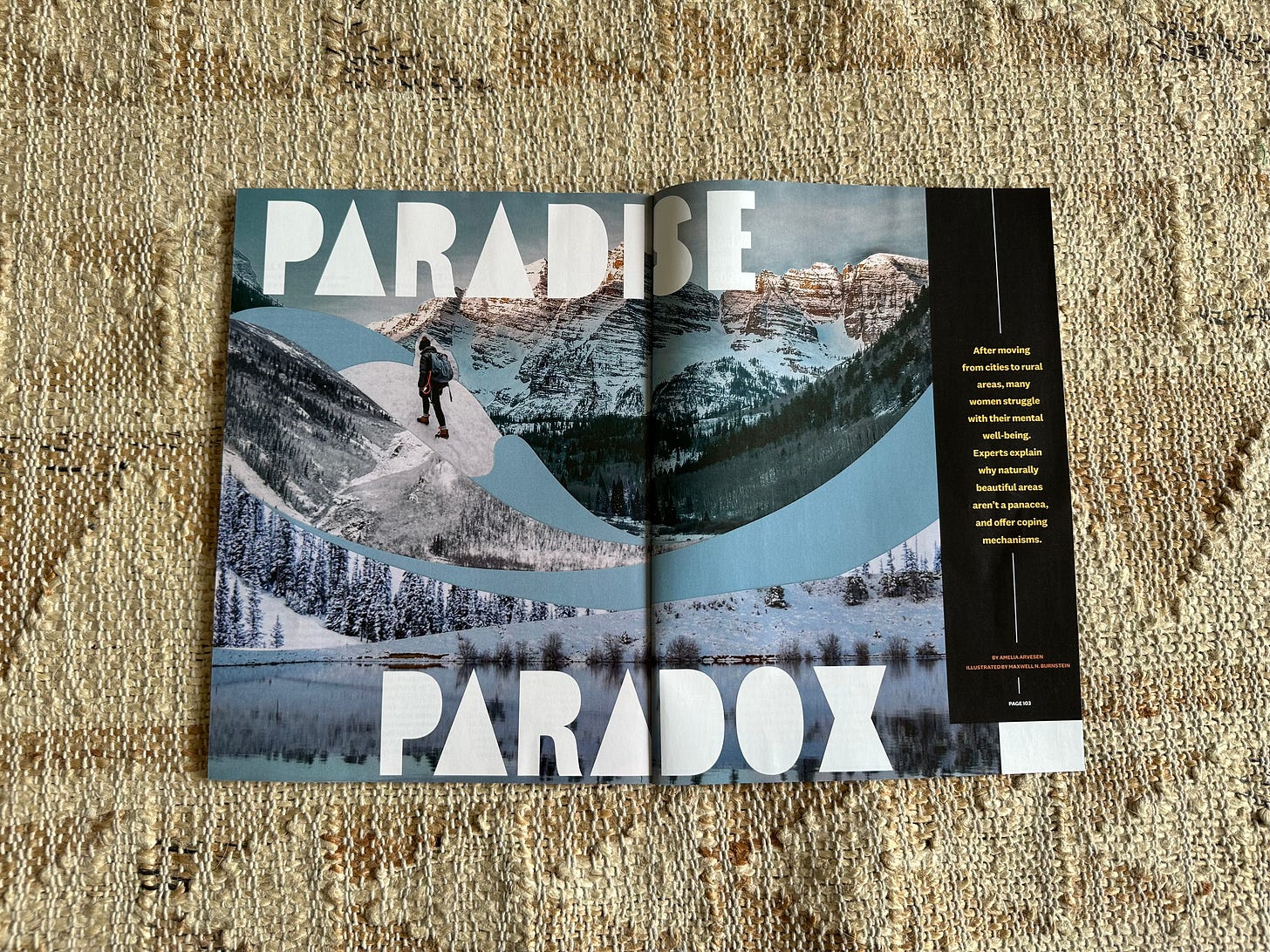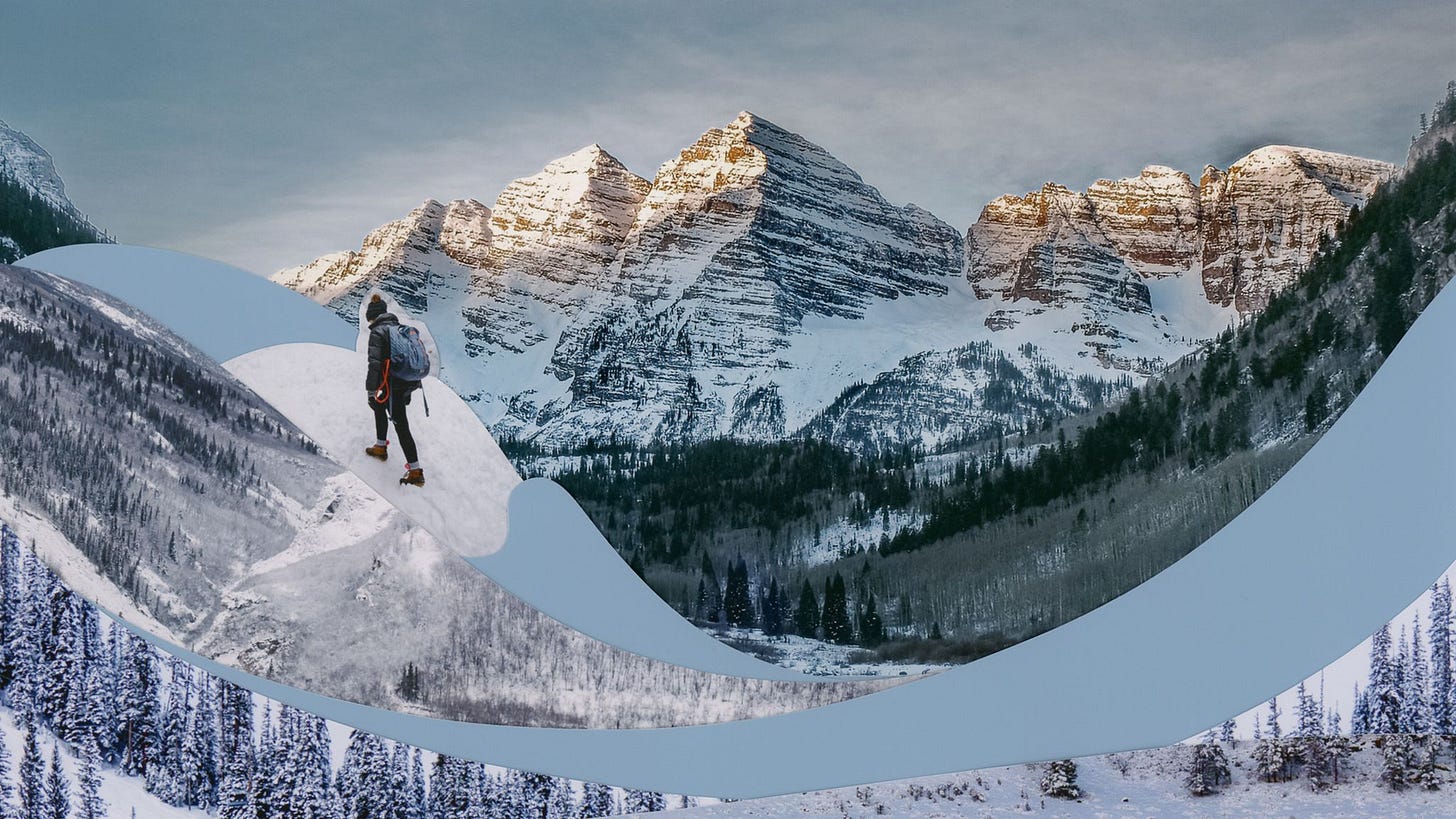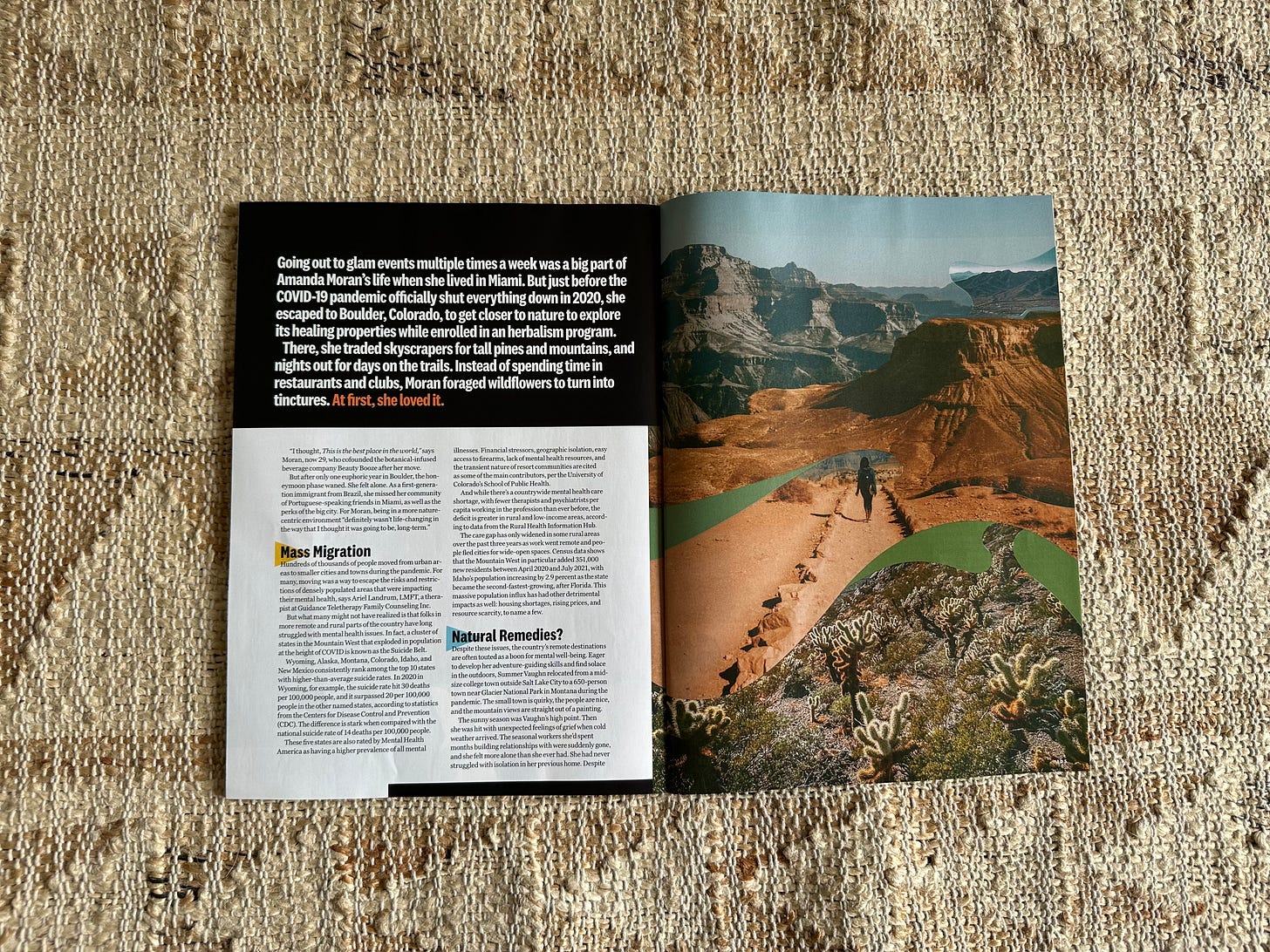Behind The Story: Writing About Mental Health
Details about my long-form reportage for Women's Health Magazine
Behind The Story is a limited series about how I, as a freelance journalist, find ideas, pitch them as stories to editors, report them, and then write them.
In fall 2020, Steve and I relocated to the mountain town of Flagstaff, Arizona. Elevation: 7,000 feet. Population: Nearly 80,000. It was the land of lodgepole pines, thin air, and starry dark skies. Without a vaccine yet, we went between the grocery store and home. No social events. No dining out. No walking around downtown. Steve’s grad school classes were online and so was my freelance work as I began to build my business. Every day, we ran or walked on the mesa with a view of the San Francisco Peaks. One of the only upsides. We thought the feeling of isolation would dissolve as the world opened back up, as we got our rounds of shots. We made a few good friends, but the deep sense of loneliness remained. It didn’t help that I was harassed on social media for one of the stories I wrote right as I was trying to make friends. Or that we experienced multiple tragic events in our two short years there. Once Steve graduated, it was time to leave.
I share this because it relates to my investigative reporting on the Paradise Paradox, the contradictory nature of mountain living. How people relocate to mountain towns for their idealistic and romanticized expectations without realizing all the difficulties that come with it: isolation, addiction, high costs, low wages, fewer resources, and thus, a higher suicide rate and prevalence of mental health issues. It was a topic I was extremely familiar with.
READ IT: Women Who Fled To Picture-Perfect Towns During The Pandemic Are Struggling With Their Mental Health (Or read it in print in the September 2023)
The Assignment
Firstly, I feel like I’ve cheated you a little bit because this is the second Behind The Story that an editor has come to me with instead of accepting my pitch. But sometimes work happens like that! In January 2023, a features editor from Women’s Health Magazine reached out needing a writer for a long-form piece. Around 3,000 words, data reporting along with interviewing diverse sources, and the chance that it appeared in print. A dream! (We were connected by my friend, who didn’t have the capacity to take on the story. Always recommend your friends!) The editor had already done the diligent work of drafting a thorough pitch that she approved with her editorial team. Then she brought it to me. Her pitch is in the footnotes for paid subscribers.1 This has been an excellent reference for what editors expect of your pre-reporting when you’re pitching long-form and investigative features. The pitch is like its own mini article.
Once again, the assignment was to report a story on how mountain towns are some of the most desired places to live but that they come with the highest rates of suicide and mental health issues in the U.S. I was asked to focus on women who moved to mountain towns and rural places during the pandemic in search of the benefits of nature and who then started reckoning with mental health issues caused or exacerbated by the challenges of living remotely. A paradox, for sure.
How I Reported It
My first step was finding women who’d be willing to talk to me on the record about their mental health struggles. I posted a callout on Instagram and Twitter, and used the site Help A Reporter Out (HARO) to cast a wider net. Friends and acquaintances responded immediately, so I kept them as backup. I always prefer interviewing sources I don’t already know, especially for investigative pieces. Then I looked for mental health professionals who could add context to the challenges of living in mountain towns. I used scientific studies to back up their anecdotes. In-the-field reporting is always preferred, but given that these women were all over the country, we arranged for Zoom meetings and phone calls. This piece required more follow-up emails than I’m used to, but it was important to me that I was accurate and over communicated given the sensitive topic.
It was crucial that I didn’t lean too much on my own experiences when asking questions so as not to lead them in a certain direction (sometimes this is so hard!). I tried to keep things open-ended but specific. Some of my questions included:
Take me back to when you moved. What prompted the relocation?
What was it like meeting new people? What came up in those interactions?
When did you notice a shift in your mental health?
What do you believe prompted it?
What were some of the things that helped you cope?
Throughout your journey, did you seek therapy or any other resources?
One of the things I would’ve done differently was talk to more women in different situations, like those with families or relocating for jobs. Many of the women I spoke to were either single or in partnerships and extremely flexible. More voices could’ve provided a more well-rounded perspective to this piece—as in any case.
How I Wrote It
Longer pieces produce an overwhelming amount of notes. I organized every interview transcription and scientific study into Notion, and highlighted key information and the most poignant quotes that might potentially end up in the story. I think I had about a month to report and write the first draft for this piece—which is shorter than I would’ve liked—so I set aside the last week for writing. The more long-form stories I write, the more I realize how formulaic they are: a lede that puts you in a specific moment, followed by establishing the “why now” or newsworthiness and relevancy of the story to the reader, and building on top of the first scene with exposition and research.
Throughout the series of edits, my lede changed from one character to another, so I also had to rewrite my ending because it tied back to the character in the previous lede. There was a change in editors during the editing phase, which brought up some confusion and complications. Parts in the first draft were removed in the second and then asked for in the third. Removed only to add them back again. It was a good reminder to always keep copies of my drafts!
I ended up not including a handful of sources for the story, but every conversation was meaningful in helping me understand the topic better beyond the previously written stories, my own experiences, and the scientific studies. Thanks to everyone who spoke to me for the piece—and to you, reader, for reading about it.
That’s all the specifics I can remember from a whole year ago, but if you have any questions, feel free to drop me a comment below!







